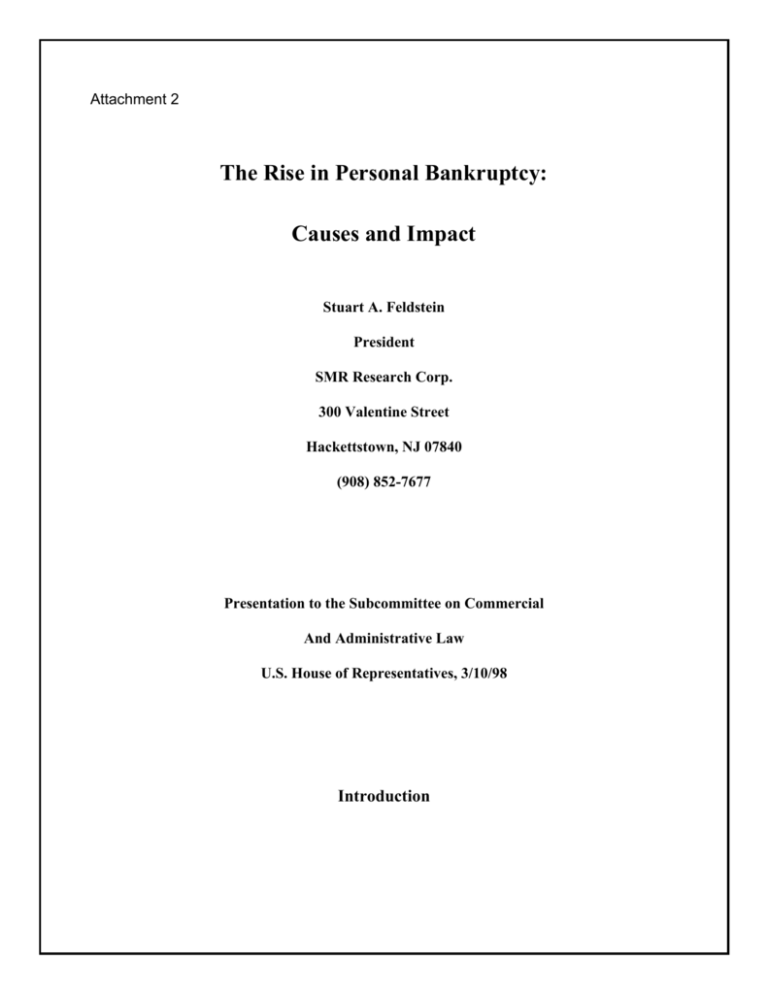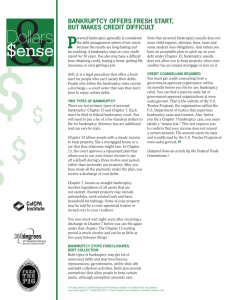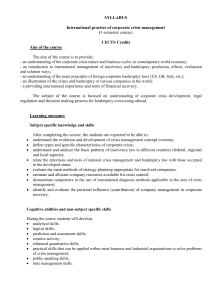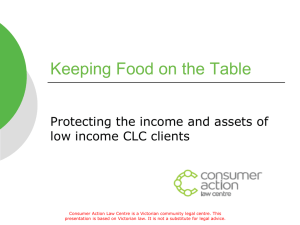The Rise in Personal Bankruptcy: Causes and Impact
advertisement

Attachment 2 The Rise in Personal Bankruptcy: Causes and Impact Stuart A. Feldstein President SMR Research Corp. 300 Valentine Street Hackettstown, NJ 07840 (908) 852-7677 Presentation to the Subcommittee on Commercial And Administrative Law U.S. House of Representatives, 3/10/98 Introduction Personal bankruptcies exceeded 1.3 million in 1997 -- a new record by far. The 1997 filings were up more than 200,000 from 1.1 million in 1996, which also had set a record. These recent annual increases alone are larger than the total number of bankruptcies was in the early 1980s. In 1998, the number of personal bankruptcy filings is highly likely to be double the level of just four years earlier; there were 773,117 filings in 1994. Clearly, we are in the midst of a wild and unprecedented escalation in personal bankruptcies. Bankruptcy filings per capita have been rising each year since 1985, except for two years (1993 and 1994). Since 1995, the pace of the increase has become explosive -- surprisingly, since the national economy is in such good shape. Unemployment is very low and jobs are growing fast. Inflation-adjusted personal incomes are rising, homes are selling in record numbers, inflation seems under control, consumer confidence is high, and banks' commercial loans are showing extremely low loss rates. How could it be that in the middle of such prosperity, we could have two consecutive years of record-setting personal bankruptcies, almost surely to be followed by another record in 1998? We believe there are multiple reasons for this. They make the problem more complex than some observers think when they lay the blame on just one causative factor or another. Our research shows that the causes of the bankruptcy increase can be put into three groups: First, there has been an increase in the frequency and the cost of certain financially disastrous events that happen to people. These events can happen solely due to bad luck, or they can be the direct result of an individual's behavior. Among these problems are divorce, lack of health insurance, the rampant spread of casino gambling, driving without auto insurance, and an increase in entrepreneurial self-employment. Second, there are three problems related to consumer debt: 1) Actual debt owed by people has grown, 2) There has been even faster growth in the amount of unused but available consumer credit lines, and 3) Since the early 1980s, consumers have amassed a great deal of adjustable rate debt, meaning that interest rate movements now change monthly loan payments. Third, we believe there are non-financial issues behind the bankruptcy increase, including greatly increased lawyer advertising and a reduction in the social stigma once associated with bankruptcy. Only these intangibles seem available to explain why bankruptcy is growing even faster than all the other reasons previously described. This paper also deals with what we believe to be some common misperceptions about why bankruptcies have increased. Finally, it touches on the impact of rising bankruptcies on solvent consumers and on financial institutions. The Rise in Economic Disasters In 1986, SMR first postulated the theory that bankruptcies were increasing, at least in part, because of an increase in the frequency or severity of so-called "insolvency events." These are financial disasters that cause family debts to spike suddenly, destroy savings, or otherwise change the monthly income to debt ratio. We developed this theory by looking at our state and local area bankruptcy filing rates per capita and then searching for correlating data sets that would explain why some places are so very much better or worse than others in filing rates. Since 1989, SMR has been collecting data on the numbers of bankruptcies filed in each U.S. county, metro area, state, and nationally, and we divide these numbers by population for a per capita bankruptcy filing rate, allowing all places to be compared fairly. One problem is divorce. Although the annual rate of divorce is now a bit lower than at its peak in the 1980s, there has been a steady, inexorable increase in the percentage of adults who, at any moment in time, happen to be divorced. Census data show that in 1965, only 2.9% of American adults were divorced, and this number has now ballooned to about 10% of all adults 18 and older. Because the annual rate of marriage is only about twice as high as the annual rate of divorce, the percentage of adults who happen to be divorced is mathematically certain to continue to rise, ultimately to 15% or even 20%, barring some major change in how well people get along. There are some obvious financial problems that come with divorce. Two people who had one monthly housing bill suddenly have two, and they have legal bills to pay, and possibly new child care costs, plus alimony and child support payments that in some cases puts a financial strain on one spouse or the other. In some cases, the worst thing that can happen is to be awarded the family home and car -- and the monthly payments that go along with them. Divorce does not necessarily cause financial disaster immediately, but can do so years later when savings are finally depleted or mandated alimony or child support payments become too great to bear. We find that per capita bankruptcy filing rates and divorce rates match well at all geographic levels tested -- even county-by-county across the country. Credit managers are well aware that divorced people in general have greater credit risk than married people, however fair credit laws prohibit the use of marital status as a criterion for granting credit. Another, and potentially greater, economic disaster strikes when people become seriously ill or injured and either don't have health insurance or else don't have enough of it. The Census Bureau reports that some 40 million Americans have no health insurance of any kind, including any government program, and this number is at or near a peak for modern times. Even if this number were not at a peak, the rise in the cost of medical services would put uninsured people at greater risk of default than they used to be. Again we find general correlation between state-level bankruptcy rates and percentages of the population lacking health insurance as reported by the Census. Places with very high bankruptcy rates often have high percentages of uninsured people, and places with low bankruptcy rates almost never have large percentages of the population lacking health insurance. Various surveys done over the last two years of bankruptcy filers consistently show that 20% or more of them cite medical debt as a major contributor to their defaults. Car insurance is another problem. Using the midpoint of two insurance industry estimates, it appears that some 25 million Americans now drive cars without car insurance. In some states, doing that is within the law, and in most of those states, the bankruptcy rate is very high, including Tennessee and Alabama. The spread of casino gambling also appears to be a problem. When we look at bankruptcy rates in counties that have major gambling facilities in them, those rates are higher than in counties that have no gambling facilities. According to the American Gaming Association, U.S. households made a record 154 million visits to gambling casinos in 1995 -- an increase of 235% over five years. On the county map in Nevada, the closer you come to Las Vegas and Reno, the higher the bankruptcy rate generally gets. In California, the highest bankruptcy rates typically are in San Bernardino and Riverside counties, which are the closest to Las Vegas, and the fourth highest rate often is in Sacramento County, closest to Reno. In New Jersey, Atlantic County, which is where the casinos are, typically has either the highest bankruptcy rate or one of the two or three highest in the state. In Tennessee, the bankruptcy rate is highest in Shelby County, the heart of Memphis, which is right across the state line from the Tunica MS casino gambling complex, reportedly the largest outside of Nevada. The AGA has officially expressed disagreement with our view that gambling is a contributor to bankruptcy. We respect their opinion; we were under the impression that in casinos, the odds favor the house and people sometimes lose. As the number of gamblers increases, so would the likelihood that some people lose a lot. Indeed, with all the risk factors just cited -- lack of health insurance, divorce, driving without insurance, and gambling -- the bankruptcy problem is actuarial. The vast majority of people who gamble will gamble responsibly. Most people without health insurance will be lucky and avoid serious injury or illness. Most divorced people will find a way to handle the financial strain. The problem is that if only 1% of these growing high-risk groups have a problem, they could account for at least 500,000 bankruptcies per year. Consumer Debt: Problems and Misconceptions One widely held belief about bankruptcies is that they have increased purely because people have more financial debt than they used to have. And, in some news articles about bankruptcy, the aggressive marketing of credit cards has been blamed as the prime culprit in this debt spiral. There is certainly some validity to the notion that increased loan debt is related to the increase in personal bankruptcies. However, the relationship between these two events has not been very strong in the 1990s, and we think there are some fundamental misunderstandings about what the connection really is between debt and bankruptcy. Both consumer debt and bankruptcies have increased in the 1980s and 1990s. But the lion's share of the debt increase hasn't been in credit cards; it's been in housing debt. All one needs to confirm that is a quick glance at the monthly Federal Reserve Bulletin, where the tables regularly break out consumer debt by category. We can compare the most recent Fed figures for 1997 to the same debt categories 10 years earlier in 1987. (Or, you can compare the current numbers against any other year in recent history and reach the same conclusions.) In 1987, the total dollars owed on residential mortgage loans were $1.959 trillion, and the total dollars owed on all forms of non-real-estate revolving debt (credit card, unsecured personal lines, and checking account overdraft loans) were $153.9 billion. In 1997, the total dollars owed on residential mortgages were $4.027 trillion, and the total owed on all revolving debt had reached $529.7 billion. So, over the 10 years, mortgage debt increased by more than $2 trillion and credit card and related debt increased by $375.8 billion. Put another way, the dollar increase in the mortgage category was more than five times the size of the increase in the credit card category. Furthermore, even these numbers understate the difference. When the Fed looks at housing debt, it only counts mortgage loans. It does not count the housing payments made by renters as being "debt." And yet, renters must make those payments every month, just as homeowners must pay their mortgage loans, and rents are higher today just as mortgage debt is higher. When you combine residential mortgage debt with a pro-forma debt amount for renters, what you find is that today, total housing debt is around $6.2 trillion -- more than 10 times the size of total credit card debt. SMR has no hidden agenda in making these observations. We have some clients in the credit card business but a lot more clients in real estate lending who may cringe to see us make these comments. It just happens to be true that most of the consumer debt in this country is housing debt, not credit card debt, and the real estate debt also is what has been increasing most rapidly by far. This means that it's very hard to be honest and blame the bankruptcy mess on aggressive lender marketing techniques. The increase in housing debt has come as a result of more people buying homes, and the escalating prices of homes. Also, mortgage lenders, for a variety of reasons, now tend to make loans at higher ratios to the values of properties than they used to do. It's not the mortgage lenders stuffing your mailbox with offers to finance your next home purchase; indeed, mortgage lenders cannot make wild offers of credit since they must first do appraisals, title checks, and other lengthy underwriting. The credit card issuers are the ones engaged in heavy marketing, yet we've just seen that their portion of total debt is small and the increase in card debt pales in contrast to housing debt. These facts call into question the notion that hyperaggressive credit card account marketing is behind the bankruptcy spike. Moreover, there are reasons to think that although levels of consumer debt are certainly related to bankruptcy, the entire connection is getting a little weak, and something else is also going on. For example, in 1993 and 1994, total consumer debt continued its normal rate of increase, but bankruptcies declined significantly. From 1995 through 1997, the rise in consumer debt moderated, but the bankruptcy rate exploded. By our estimate, the U.S. consumer debt-to-income ratio actually improved in 1997 over 1996, mainly because incomes got better, and this happened just as bankruptcies reached a new record high. Further, consumer debt to income ratios fail to correlate with bankruptcy rates at the state, MSA, or county levels as shown in our database. The greatest single variable in the consumer debt load from one state or locale to another is the cost of housing; it is the largest piece of debt and annual housing costs can vary by three-fold from one place to another, like California versus Mississippi. But many places with reasonably low ratios of debt to income also have some of the nation's highest bankruptcy filing rates -- like Tennessee, Alabama, and Mississippi. Other states not so distant from these have low d-t-i ratios and low bankruptcy rates, like North and South Carolina. There are states with high d-t-i ratios and high bankruptcy rates, like California, Oregon, Nevada, and Virginia, and states with high d-t-i ratios and much lower bankruptcy rates, like Delaware, New Hampshire, and Maryland. In short, it's very hard to see any pattern at all in these data. There are two other aspects of consumer debt that probably do play a role in bankruptcy. One is adjustable rate debt and the other is debt that's unused but available to consumers. I noted earlier that bankruptcies fell in 1993 and 1994 -- the only two years out of the last 12 when that happened. How come? The only explanation we know of is interest rates and adjustable debt. As recently as 1980, there was literally not a dollar of consumer debt with an adjustable rate. Today, we estimate that more than $1.5 trillion of adjustable rate consumer debt exists, most of it comprised of adjustable rate mortgages. This means that when prevailing interest rates rise, monthly debt payments rise later (often lagging one year) for millions of Americans, and when interest rates fall, monthly payments get easier. In 1993 and 1994, bankruptcies fell after interest rates had declined very significantly, and then rates went back up rather dramatically in later 1994 and in 1995, followed by a bankruptcy surge. Finally, there's the matter of available debt. I said earlier that credit cards cannot be blamed for the rise in total consumer debt, but what they have done is dramatically increase the credit lines that are available to people who may get in financial trouble for other reasons. In mid-1997, we tallied the total extended credit card lines of all U.S. banks at yearend 1996, using bank call and income regulatory reports and other data, and the number was $1.78 trillion. That was nearly double the amount of 1993, just three years earlier. The $1.78 trillion is not what people owed; it is the amount of their total credit lines on plastic. Americans typically only draw down an average of 20-25% of their available credit card lines. The problem is that if an average consumer does get into financial trouble for any reason, he now has much greater ability to turn to his untapped credit card lines to forestall the day of reckoning. By the time he ends up in bankruptcy court, he can have massively larger unsecured debts than he could have had before, because credit card issuers have been making such large increases in available lines to try to keep their customers happy and avoid losing them to competitors. So in our opinion, credit card issuers are being unfairly treated by their critics in some regards, while on the other hand most of the critics haven't really noticed what the card issuers actually have done to exacerbate the cost of bankruptcy. We have advised credit card issuers in our research publications to stop using large credit lines as a marketing tactic. The Intangible Issues: Hard To Measure, But They Exist The really interesting thing about all the problems I've just described is that they explain some of the bankruptcy mess, but not all of it. Personal financial disasters and per capita debt-to-income ratios have worsened gradually. They did not get worse by 29% in 1996 over 1995, but bankruptcies did. They did not worsen again by 20% in 1997 over 1996, but bankruptcies did. So, the hunt for causes of bankruptcy isn't over yet. The only available conclusion is that certain intangibles are playing a role. One is lawyer advertising. Like adjustable rate debt, you rarely saw any lawyer advertising for bankruptcy prior to about the mid-1980s. In fact, lawyers didn't advertise for much of anything. Today, lawyer advertising for bankruptcy is prevalent and often provocative. We did a brief study of telephone book ads and found that cities with high bankruptcy filing rates usually do have higher levels of lawyer advertising than cities with low filings rates. A recent look through the Las Vegas Yellow Pages shows more than 100 pages of lawyer advertising, of which roughly one in 10 mentions or is devoted to bankruptcy. Las Vegas has one of the highest urban area bankruptcy rates. We're sure lawyers would argue that they are merely responding to higher demand for their services. But since the whole purpose of advertising in any business is to sell products and services, we would imagine that advertising for bankruptcy gets results, too, and helps convince at least some people to use bankruptcy to eliminate their debts. We have no idea how to measure this precisely. At the same time, we agree with Fed Chairman Greenspan, who has attributed the bankruptcy increase to a general loss of social stigma once attached to the subject. We can see in our database a very interesting fact along these lines. Places that used to have very low bankruptcy rates back in 1989, when we started compiling the data, have had a mixed experience since then. Some have stayed low, and some have gotten a little worse, and some have gotten a lot worse. But when we look at places that had very high bankruptcy rates back in 1989, they've virtually all stayed high and never got better. Why would that be? Certainly, one explanation must be that when bankruptcy filing becomes common in a local area, everyone ends up knowing someone who did it. Bankruptcy becomes de-mystified and begins to lose its embarrassment. Indeed, if you know a person who ended up prospering as a result of bankruptcy, then bankruptcy certainly may begin to sound like a smart strategy -- like a mortgage refinance. At the same time, consumers have watched the stigma of bankruptcy disappear in the business world. The airlines have filed for bankruptcy -- some more than once -- and yet the planes usually keep flying. Retailers have filed, yet the stores stay open. Bankruptcy thus must be something other than financial disaster. Impact of Personal Bankruptcies What impact are bankruptcies having on consumers and on the nation's financial institutions? The short answer is that rising bankruptcies are impacting all consumers and some, but not all, lenders. Many large commercial banks have been reporting record or near-record profits. That is true in part because some banks do more commercial lending than consumer lending, and it's also true because financial institutions pass along the cost of bankruptcy in their rates and fees, as they do with other costs. The same could be said of non-bank creditors. Any business is a creditor when it provides good or services and waits to be paid for them later on: electric and gas utilities, phone companies, landlords, retail stores with credit cards or other credit plans, doctors, dentists, hospitals, and others. All these businesses extend credit without collateral and lose what they are owed when unsecured debts are expunged in bankruptcy. So, the cost of bankruptcy is included on the expense side of the income statement. Banks put bankruptcy costs in their "provisions for loan losses;" AT&T includes its bankruptcy costs in a line on its income statement called "uncollectible bills." Consumers may or may not be aware of it, but most of what they spend every month has a bankruptcy cost factor built into it, from the phone bill to the car payment to the rent and the credit card bill. Lenders' business can be divided into two basic parts: loans made to individuals and loans made to businesses. Recently, business lending has been very profitable. Loan demand has been strong thanks to the economy and credit quality has been excellent. Oddly enough at a time when consumer bankruptcies are skyrocketing, credit quality on commercial loans is the best we've seen in many years. As recently as the late 1980s, commercial mortgage loans and loans on apartment buildings had very high delinquency and loss rates, due in part to sloppy lending and due in part to the fact that shopping centers, apartments, and office buildings were overbuilt in the 1980s. Today, when we aggregate the FDIC call and income reports of commercial banks -- and even when we look at the quarterly financial reports of the nation's remaining thrifts -- we see the opposite. Net chargeoffs are now extremely low on commercial mortgages and apartment building mortgages, as well as on non-real-estate commercial and industrial loans made to corporations for miscellaneous purposes. So, one reason behind good bank profits is the extraordinary strength of commercial lending. When we turn to loans made to individuals, we must subdivide that world into secured and unsecured loans. All of these are indeed being impacted by the personal bankruptcy increase, but the bulk of these loans are in 1-4 unit residential mortgages, which have homes as collateral. Lender losses on mortgages are comprised of chargeoffs when loans go into foreclosure minus recoveries when the foreclosed properties get sold. Here again, the strong economy and the super-powered housing market have helped enormously. In both 1996 and 1997, we saw record numbers of home purchases, plus accelerating average home prices. This has meant that foreclosed homes coming onto the market are selling rapidly and for good prices, enabling mortgage lenders to recover a substantial portion of their charged off loans. Of course, if the housing market slows, as it eventually must, then we will see more damage to mortgage lenders from bankruptcies. I know that the Mortgage Bankers Association is worried about this. Let's move to unsecured lenders. Here, we do see the impact of personal bankruptcies now. Each year, SMR produces a combined income statement for credit card banks, using the FDIC call reports and defining these banks as any banks whose credit card outstandings are more than 50% of their total loans. There are about 60 such banks in the United States, and they represent well over half of all credit card receivables. From 1994 to 1996, these banks as a group saw their after-tax profits as a percent of average managed assets decline from 2.26% to 1.31%, and the principle reason was the increase in the provision for loan losses, in turn higher due to escalating bankruptcies. When we calculate profitability for card issuers in 1997, in about a month, we strongly believe we'll see the 1.31% margin fall further to just over 1% even. Some credit card banks already have been unable or unwilling to cope, hence we have seen such events as Advanta Corp. recently selling its ailing card business to Fleet, and AT&T selling its card business to Citicorp. Credit card profitability, although much reduced, is still OK for the time being. The reason for that is simple: Credit card issuers have raised their prices to help compensate for bankruptcies. It's not the interest rates on credit cards that have gone up, but the fees. About 10 years ago, in 1987 and 1988, our collection of credit card direct mail pieces shows that late payment fees most typically were $5 or $10. In 1996, card issuers really started raising these fees, and they now usually range from $15 to $25. Also back in 1987 and 1988, many issuers charged no fees at all when consumers exceeded their credit line limits, although some charged $5 or $10. Now, over-limit fees also have jumped to the $15 to $25 range. The fastest-rising cost in credit cards is consumer bankruptcy, so these fee increases are being used to help pay for that cost and keep profits up. These new fees are arguably unfair, since they cannot be assessed on the bankruptcy filers who have caused them, and instead are charged to a class of people who can least afford to pay for them: people who have not filed for bankruptcy but are late payers or are over their credit limits, often due to financial stress. That's unfortunate, but how do you make a price increase fair when you cannot assess it on the customers who cause a cost increase? We have tried to estimate the public cost of bankruptcy, although this is not easy to do. The right method would be to have someone follow through to fruition all bankruptcy cases and add up all the amounts of debt ultimately discharged. No one I know has the time or money to do this. So, we can only use available data to make rough estimates of the cost of bankruptcy. One method is to look at how many good-paying customers creditors need to offset the impact of a single bankruptcy. For creditors, bankruptcy is a pre-tax expense. Our method is to look at the typical pre-tax profit earned by lenders per household and see how many households are needed to offset the cost of a bankruptcy filing. As of June, 1997, total outstanding consumer debt was $7.2 trillion, including a pro-forma debt amount for renters. Total outstanding financial debt per U.S. household turns out to be $72,455. In 1996, the most recent full year available, all U.S. banks as a group earned pre-tax profits of 1.74% of their outstanding assets, therefore their earnings per household would be 1.74% of the $72,455, or $1,261. The average amount discharged in a personal bankruptcy appears to be somewhere around $41,000, by our estimate from data compiled by Visa and the Credit Research Center. So, if you earn $1,261 from good-paying households per year, you divide that into the $41,000 you lose in a bankruptcy and conclude that it takes 33 good-paying households to pay for a single bankruptcy case. In some ways, this impact is understated. In our compilation of debt, we did include a pro-forma amount for renters, but in fact the lenders don't get that money, landlords do. If you subtract the renter debt, you end out with total U.S. consumer debt of $5.139 trillion, or about $51,390 per U.S. household. Then, the lenders' pre-tax margin of 1.74% yields pre-tax income of $894 per household, and suddenly you find it takes 46 good-paying households to make up for one bankruptcy. The following table shows the more conservative assumption and concludes this paper. Number of good-paying households it takes to pay for one personal bankruptcy case: Total consumer financial debt (includes all loan debts and rent, but not medical, utilities, or other debts or monthly expenses) Source: Federal Reserve Bulletin, 6/97 1-4 unit residential mortgage debt -- $3,912,079,000,000 Pro-forma housing debt of renters -- $2,106,504,000,000 Auto debt -- $ 380,809,000,000 Revolving (card) -- $ 491,813,000,000 Other loans -- $ 354,339,000,000 Total consumer financial/rent debt: $7,245,544,000,000 1 1 Pro-forma debt of renters calculated by SMR. Homeowners are 65% of all households and renters are 35% (Census Bureau). Since renters have to pay monthly amounts just like homeowners with mortgages, we have added this pro-forma number based on the 35% of households being renters. # of households in the United States: 100 million Financial Debt/Household: $72,455 All banks, pre-tax return on assets in 1996: 1.74% Financial industry pre-tax profits per household: ($72,455 X 1.74%): $1,261 Average amount discharged in a personal bankruptcy: $41,000 (Staten & Visa data, from samplings) Number of good, bill-paying households needed to compensate for one bankruptcy filer ($41,000/$1,261): 33 About SMR Research SMR Research Corp. is the nation's largest publisher of market research studies on consumer loan subjects and also produces a variety of statistical research products. Founded in 1984, SMR publishes annual or semi-annual studies of the residential mortgage, home equity loan, and credit card markets. SMR also produces statistics and studies on consumer credit risk, and these have included three published studies of personal bankruptcy and its causes since 1992. The largest of these studies was published in May of 1997 and was entitled: The Personal Bankruptcy Crisis: 1997. SMR also maintains an extensive bankruptcy filings electronic database, which includes filings and filing rates per capita, for all U.S. counties, states, metropolitan statistical areas, and the nation, updated quarterly and with a history back to 1989. SMR is an independent firm and funds its own research publications, which are available for purchase to anyone. Clients for SMR published research have included a majority of larger U.S. banks, savings and loans, mortgage companies, life insurance companies, consumer finance companies, and brokerage houses, plus some government agencies, government-sponsored enterprises, oil companies, retailers, and others. Stuart A. Feldstein is president of SMR. Formerly editor of the Corporate Strategies section of Business Week magazine, Mr. Feldstein has been the senior author or editor of SMR studies since 1984. George R. Yacik and Leigh A. Smith are vice presidents of SMR. Mr. Yacik, formerly an executive at the American Banker newspaper, helps manage SMR's publishing business. Mr. Smith, formerly a research executive at Barnett Banks, manages SMR's data products business. SMR is based in Hackettstown, NJ.









